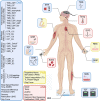Neural dysregulation in post-COVID fatigue
- PMID: 37304792
- PMCID: PMC10257363
- DOI: 10.1093/braincomms/fcad122
Neural dysregulation in post-COVID fatigue
Abstract
Following infection with SARS-CoV-2, a substantial minority of people develop lingering after-effects known as 'long COVID'. Fatigue is a common complaint with a substantial impact on daily life, but the neural mechanisms behind post-COVID fatigue remain unclear. We recruited 37 volunteers with self-reported fatigue after a mild COVID infection and carried out a battery of behavioural and neurophysiological tests assessing the central, peripheral and autonomic nervous systems. In comparison with age- and sex-matched volunteers without fatigue (n = 52), we show underactivity in specific cortical circuits, dysregulation of autonomic function and myopathic change in skeletal muscle. Cluster analysis revealed no subgroupings, suggesting post-COVID fatigue is a single entity with individual variation, rather than a small number of distinct syndromes. Based on our analysis, we were also able to exclude dysregulation in sensory feedback circuits and descending neuromodulatory control. These abnormalities on objective tests may aid in the development of novel approaches for disease monitoring.
Keywords: COVID; dysautonomia; fatigue; myopathy; transcranial magnetic brain stimulation.
© The Author(s) 2023. Published by Oxford University Press on behalf of the Guarantors of Brain.
Conflict of interest statement
The authors report no competing interests.
Figures





References
-
- McCrone P, Darbishire L, Ridsdale L, Seed P. The economic cost of chronic fatigue and chronic fatigue syndrome in UK primary care. Psychol Med. 2003;33(2):253–261. - PubMed
-
- Office for National Statistics . Prevalence of ongoing symptoms following coronavirus (COVID-19) infection in the UK. 2022.https://www.ons.gov.uk/peoplepopulationandcommunity/healthandsocialcare/... [Accessed 6.1.2022]
Grants and funding
LinkOut - more resources
Full Text Sources
Miscellaneous
